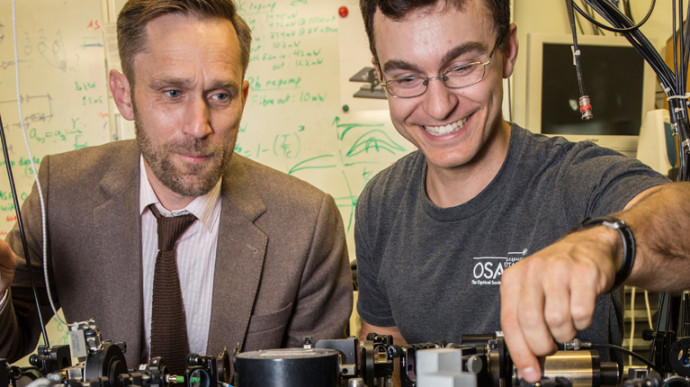News
Published 10 October 20172017 Hatherton Award: Demonstrating the no side-stepping rule of quantum mechanics

Ryan Thomas has received the Hatherton Award for his paper on particle collisions that demonstrates and extends our understanding of the Pauli exclusion principle, which places fundamental constraints on where certain atomic particles can be located. Royal Society Te Apārangi presents this award to the best scientific paper by a PhD student at any New Zealand university, studying chemical, physical, mathematical or information sciences.
The Pauli exclusion principle applies to a class of particles known as fermions, and it underlies the periodic table: electrons are constrained in how they organise themselves around the atom and elements in the same group share chemical properties. When studying collisions of fermions, the exclusion principle holds that they cannot scatter out at 90 degrees to the collision axis, known as the ‘no-side-stepping’ rule, which creates a scattering pattern that looks like a dumbbell weight.
Based at the University of Otago in Professor Niels Kjærgaard’s lab, Ryan used lasers to collide clouds of ultra-cold potassium atoms and recorded their scattering. The ultra-cold atomic clouds had a temperature of a mere millionth of a degree kelvin above absolute zero and were confined and accelerated by accurately controlled laser beams. His results, published in Nature Communications, are the first direct observation of the ‘no-side-stepping’ rule even after multiple collisions, and he used sophisticated modelling to elucidate this.
Ryan’s paper also demonstrated another principle, known as the Wigner threshold law, which states that at very low collision energies no scattering occurs and the atomic clouds would pass right through each other, rather than colliding and scattering.
The award selection committee noted that Ryan had demonstrated both technological and theoretical excellence in producing this paper, which has demonstrated the value of a collider-based approach for studying atomic interactions under ultra-cold conditions.
Ryan says he is honoured to receive the Hatherton Award. “I am grateful to all my colleagues and especially to my supervisor, Dr Niels Kjærgaard, for their support on this work. This award shows the uniqueness and importance of our approach to studying atomic collisions, and I am excited to see where future research in this field takes us."
Prior to obtaining a scholarship to undertake his PhD at the University of Otago, Ryan completed a Master’s degree at the University of Calgary, Canada following a Bachelor of Science – Honours at Simon Fraser University in British Columbia where he received the Governor General’s Silver Academic Medal, which is awarded for the highest-grade average at the university. In 2010 he received the Ralph Steinhauer Award of Distinction and the Bill Bridger Award. He received Best Postgraduate Paper in the Division of Sciences at the University of Otago in 2016.
The Hatherton Award
For the best scientific paper by a PhD student at any New Zealand university in chemical sciences, physical sciences, mathematical and information sciences.
Citation:
To Ryan James Thomas for experimental work leading to the first direct observation of pure p-wave patterns in the quantum scattering of indistinguishable fermions and for demonstrating how deviations from p-wave purity can be used to classify multiple scattering dynamics.
Publication details:
R. Thomas, K. O. Roberts, E. Tiesinga, A. C. J. Wade, P. B. Blakie, A. B. Deb, N. Kjærgaard, Multiple scattering dynamics of fermions at an isolated p-wave resonance, Nature Communications 7, 12069, 11 Jul 2016
